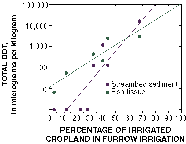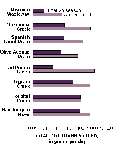
U.S. Geological Circular 1225--The
Quality of Our Nation's Waters--Nutrients and Pesticides
|
CONTROL OF SOIL EROSION IS KEY TO REDUCING ORGANOCHLORINE
INSECTICIDES
Organochlorine insecticides bind strongly to soils and
are carried with eroded soils to streams by runoff from irrigation and
rainfall. In streams, the soil-bound insecticides may dissolve in water,
remain suspended, or settle to the streambed. They also accumulate in
fish. Under-standing and managing soil erosion is a key to reducing organochlorine
contamination.
For example, furrow irrigation causes more erosion than
sprinkler or drip irrigation. In the Central Columbia Plateau, DDT concentrations
in streambed sediment and fish increased as the percentage of furrow irrigation
in the basin increased.
In the San Joaquin-Tulare Basins, the amount of DDT transported
with suspended sediment in the San Joaquin River and tributaries generally
was greater during winter runoff than during the irrigation season. Controlling
irrigation-induced soil erosion would reduce but not eliminate DDT in
the streams because large quantities are transported during infrequent
storms. |
Organochlorine insecticides were highest in urban streams
and where historical agricultural use was greatest
Concentrations of organochlorine insecticides in bed sediment and fish
correspond to land use and past application rates. Although most uses
of organochlorine insecticides ended 10 to 25 years ago, they remain a
significant water-quality issue for many streams. Overall, 14 percent
of bed-sediment samples had concentrations that exceeded sediment-quality
guidelines for protection of aquatic life,(39)
and 19 percent of sites had concentrations in fish that exceeded New York
guidelines for protection of fish-eating wildlife.(40)
Compounds that most often exceeded guidelines were DDT and chlordane in
bed sediment and DDT and dieldrin in fish.
Almost all urban streams had high or medium concentrations of the organochlorine
insecticides compared with other sites. Sediment-quality guidelines were
exceeded at 37 percent of urban sites, with several sites each in urbanized
areas of the Connecticut, Housatonic, and Thames River Basins, Hudson
River Basin, Trinity River Basin, and Georgia-Florida Coastal Plain. Concentrations
in whole fish exceeded guidelines for the protection of fish-eating wildlife
at 21 percent of urban sites.
In agricultural streams, concentrations of organochlorine insecticides
were highest in areas of high past use. High concentrations were most
common for streams in the Central Columbia Plateau, Georgia-Florida Coastal
Plain, and Trinity River Basin. One or more sediment-quality guidelines
were exceeded at 15 percent of agricultural sites, and concentrations
in whole fish exceeded wildlife guidelines at 20 percent of sites.
Many streams and rivers with mixed land-use influences also had high
concentrations in bed sediment, particularly in basins with extensive
agricultural areas where past use was high, such as in the Southeast and
the irrigated West, and in basins with high population density, such as
in the Northeast. Sediment-quality guidelines were exceeded at 11 percent
of these sites, and wildlife guidelines were exceeded in whole fish at
24 percent of these sites. In undeveloped areas, organochlorine concentrations
generally were low and did not exceed sediment-quality guidelines.
A significant health concern in some regions is consumption of fish with
high levels of organochlorine insecticides in their flesh. Human-health
guidelines for edible fish tissue(41)
are not directly applicable to NAWQA results, which are based on whole-fish
analysis of mostly carp and suckers. Nevertheless, the NAWQA fish data
provide a relative indication of potential concern. At about 30 percent
of NAWQA sites, insecticide concentrations in whole fish exceeded human-health
guidelines for edible fish tissue.(41) For any of these streams that are
active fisheries, additional assessment of fillets of edible species is
advisable if this has not already been done.




